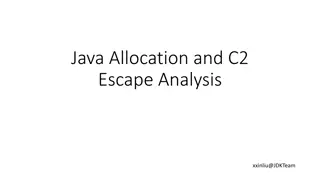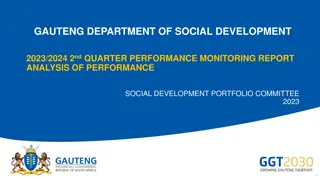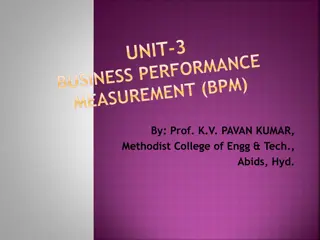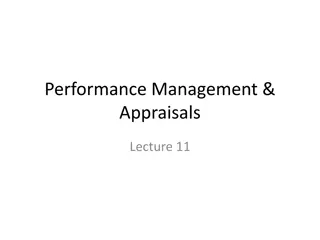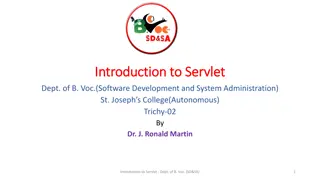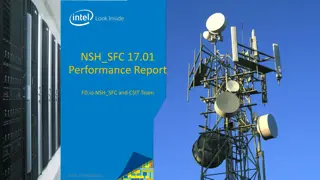
Understanding JVM Performance Optimization
Dive into the complexities of JVM performance optimization, including details on Java code execution, HotSpot interpretation, virtual method tables, and inline caches. Learn about the challenges in achieving optimal performance and how the JVM handles method invocations efficiently.
Uploaded on | 0 Views
Download Presentation

Please find below an Image/Link to download the presentation.
The content on the website is provided AS IS for your information and personal use only. It may not be sold, licensed, or shared on other websites without obtaining consent from the author. If you encounter any issues during the download, it is possible that the publisher has removed the file from their server.
You are allowed to download the files provided on this website for personal or commercial use, subject to the condition that they are used lawfully. All files are the property of their respective owners.
The content on the website is provided AS IS for your information and personal use only. It may not be sold, licensed, or shared on other websites without obtaining consent from the author.
E N D
Presentation Transcript
An introduction to JVM performance
Performance-talk disclaimer EVERYTHING IS A LIE!! Please keep in mind: The JVM s performance model is an implementation detail you cannot rely on. Performance is hard to get right and it is difficult to measure. We look at HotSpot in this talk, other JVMs might behave differently. Occasionally, implementations are performant without appearing to be.
How is Java code executed? Java javac processor JVM source code byte code machine code Optimizations are applied almost exclusively after handing resposibility to the JVM. This makes them difficult to trace as the JVM is often seen as a black box. Other compilers such as for example scalac might however apply optimizations such as resolving tail recursion into ordinary loops.
HotSpot: interpretation and tiered compilation interpreter C1 (client) C2 (server) machine code templating advanced profiling simple profiling no profile-based optimization profiling level 0 level 1 level 2 level 3 level 4 C2 is busy trivial method Mostly, steady state performance is of interest. Compilation only of hot spots with a single method as the smallest compilation unit.
A central building block: call sites class Foo { void bar(){ System.out.println("Hello!"); } } indirection void doSomething(Foo val){ val.bar(); } A call site, that is a specific method call instruction in the code. Other than in many languages, in Java, most method calls are virtual. The question is: How does the JVM reason about what code to execute? Method invocation is a very common task for a JVM, it better be fast!
Virtual method tables (vtables / itables) class Foo { void bar(){ System.out.println("Hello!"); } } # Method Code 1 hashCode() 0x234522 2 equals(Object) 0x65B4A6 3 toString() 0x588252 8 bar() class Foo class Sub extends Foo { @Override void bar(){ System.out.println("Woops!"); } } # Method Run 1 hashCode() 0x234522 2 equals(Object) 0x65B4A6 3 toString() 0x588252 8 bar() class Sub Single inheritance allows for index-based lookup of a method implementation. But resolving this triple indirection on every method call is still too slow!
Inline caches class Foo { void bar(){ System.out.println("Hello!"); } } cached link void doSomething(Foo val){ val.bar();[cache: val => Foo: address] } Inline caches observe instance classes and remember the address of a class s method implementation. This would avoid the lookup in a virtual method table. Smalltalk is a prominent user of such caches. But this double indirection is still to slow!
Monomorphic (linked) call site class Foo { void bar(){ System.out.println("Hello!"); } } direct link void doSomething(Foo val){ [assert: val => Foo] [goto: method address] } The JVM has created a profile for this call site. It is now optimisitc about what instances it will observe. The JVM is based on making optimistic assumptions and adding traps when these assumptions are not met ( adaptive runtime ). Heuristics show that most call sites only ever observe a single class ( monomorphic ). These same heuristics also show that non-monomorphic call sites often observe many types ( megamorphic ).
monomorphic bimorphic polymorphic megamorphic deoptimization conditional direct link vtable lookup home of rumors direct link (about 90%) (but dominant targets) (data structures) optimization A call site s profile is generated at runtime and it is adapted after collecting sufficient information. In general, the JVM tries to be optimistic and becomes more pessimistic once it must. This is an adaptive approach, native programs cannot do this.
Inlining class Foo { void bar(){ System.out.println("Hello!"); } } inlined void doSomething(Foo val){ [assert: val => Foo] System.out.println("Hello!"); } } void doSomething(Foo val){ [assert: val => Foo] [goto: method address] Inlining is often consider an uber optimization as it gives the JVM more code to omtimize as a single block. The C1 compiler does only little inlining after performing class hierarchy analysis (CHA). The C2 compiler inlines monomorphic and bimorphic call sites (with a conditional jump) and the dominant target (> 90%) of a megamorphic call site. Small methods (< 35 byte) are always inlined. Huge methods are never inlined.
Call receiver profiling: every type matters! List<String> list =... // either ArrayList or LinkedList list.size(); // a bimorphic call site // new class turns call site into megamorphic state new ArrayList<String>(){{ add("foo"); add("bar"); }}; When the JVM profiles call sites or conducts class hierarchy analysis, it takes the receiver type at a call site into consideration, it does not analyze if a method is actually overridden. For this reason, every type matters (even when calling final methods). You might wonder why this is not optimized: Looking up an object s class is an order-one operation. Examining a class hierarchy is not. The JVM needs to choose a trade-off when optimizing and analyzing the hierarchy does not pay off (educated guess). Double brace initialization is a however often introducing new (obsolete) types at call sites. Often enough, this results in vtable/itable lookups!
Microoptimizing method dispatch interface Foo { void m(); } class Sub1 implements Foo { @Override void m(){...}} class Sub2 implements Foo { @Override void m(){...}} class Sub3 implements Foo { @Override void m(){...}} static void sub2(){...} static void sub3(){...} } class Foo { int id // 1, 2, 3 static void sub1(){...} Idea: avoid dynamic dispatch but emulate it at the call site. ( call by id ) void doSomething(Foo foo){ foo.m(); } case 1: Foo.sub1();break; case 2: Foo.sub2();break; case 3: Foo.sub3();break; default:thrownew IllegalStateException(); } } void doSomething(Foo foo){ switch (foo.id){ Fields are never resolved dynamically. Static call sites always have an explicit target. If all three types are observed, this call site is megamorphic. A target is only inlined if it is dominant (>90%). Do not microoptimize, unless you must! The improvement is minimal. In general: static/private > class virtual (null check) > interface virtual (null + type check). This is true for all dispatchers (C2, C1, interpreter) Source: http://shipilev.net/blog/2015/black-magic-method-dispatch/
Call site specialization static void log(Object... args){ System.out.println("Log: "); for(Object arg : args){ System.out.println(arg.toString()); } } inlined void doSomething(){ System.out.println("Log: "); void doSomething(){ System.out.println("Log: "); System.out.println("foo".toString()); System.out.println(new Integer(4).toString()); System.out.println(new Object().toString()); } } } void doSomething(){ log("foo", 4,new Object()); } Object[] args = new Object[]{"foo",4,new Object()}; for(Object arg : args){ System.out.println(arg.toString()); Unroll the entire loop as it is now of a fixed size. Thanks to inlining (and loop unrolling), additional call sites are introduced. This way, formerly megamorphic call sites can become monomorphic after duplication. Generally, optimizations allow for new optimizations. This is especially true for inlining.
The Hulk performance rule #1 ONE TYPE GOOD! MANY TYPES BAD!
All programs are typed! Types (which do not equal to classes) allow us to identify things in our programs that are similar. If nothing in your program has similarities, there might be something wrong. Thus, even machines for dynamic languages look for types. (e.g. V8, Nashorn) var foo ={}; foo.x = 'foo'; foo.y = 42; V8, hidden class * x var bar ={}; bar.y = 42; bar.x = 'bar'; x, y y If your program has no structure, how should an optimizer find any? Any dynamic program is typed, but it is so implicitly. In the end, you simply did not make this structure explicit. y, x
Branch prediction int size = 20_000; int maximum = 100; int[] values = randomValues(size, maximum); Arrays.sort(values); int sum = 0; for(int i = 0; i < 1_000; i++){ for(int value : values){ if (value > 50) { sum += value; } else { sum -= value; } } } A conditional control flow is referred to as branch. Can the outcome of this conditional instruction be predicted (by the processor)? Warning: This example is too simple, the VM (loop interchange, conditional moves) has become smarter than that. After adding more noise , the example would however work. An unfortunate example where the above problem applies are (currently!) Java 8 streams which build on (internal) iteration and conditionals (i.e. filters). If the VM fails to inline such a stream expression (under a polluted profile), streams can be a performance bottle neck.
Loop peeling (in combination with branch specialization) int[][] matrix =... for(int[] row : matrix){ boolean first =true; for(int value : row){ if(first){ first =false; System.out.println("Row: "); } System.out.print(value + " "); } System.out.println(" --- "); } first =false; System.out.println("Row: "); } System.out.print(value + " "); } System.out.println(" --- "); } int[][] matrix =... for(int[] row : matrix){ boolean first =true; int index = 0; if(first){ first =false; System.out.println("Row: "); } System.out.print(value + " "); for(index = 1; index < row.length; index++){ if(first){ Disclaimer: There is much more loop stuff .
The Hulk performance rule #2 PREDICTION GOOD! RANDOM BAD! Keep in mind: Obviously, any application contains an inherent unpredictability that cannot be removed. Performant programs should however not add more complexity as necessary as this burdens modern processors which prefer processing long, predictable pipes of instructions.
Escape analysis List<String> list =...; for(String s : list){ System.out.println(s); } System.out.println(it.next()); } List<String> list =...; Iterator<String> it = list.iterator(); while(it.hasNext()){ scope object allocation Any heap allocated object needs to be garbage collected at some point. Even worse, accessing an object on the heap implies an indirection what should be avoided. Escape analysis is difficult (expensive) to conduct. By avoiding long scopes, i.e. writing short methods, an object s scope is easier to determine. This will most likely improve in future JVM implementations.
The Hulk performance rule #3 STACK GOOD! HEAP BAD!
Dead-code elimination int size = 20_000; int[] values = randomValues(size); int[] values = randomValues(size); int size = 20_000; long start = System.currentTimeMillis(); int sum = 0; for(int value : values){ sum += value; } } int sum = 0; for (int value : values) { sum += value; long end = System.currentTimeMillis(); System.out.println("Took " +(end - start)+ " ms"); Also, the outcome might dependant on the JVM s collected code profile that was gathered before the benchmark is run. Also, the measured time represents wall-clock time which is not a good choice for measuring small amounts of time.
A better benchmark void run(){ int size = 500_000; for(int i = ; i < 10_000; i++){ doBenchmark(randomValues(size)); } int[] values = randomValues(size); System.out.println("This time is for real!"); doBenchmark(values); } void doBenchmark(int[] values){ long start = System.nanoTime(); int sum = 0; for(int value : values){ sum += value; } long end = System.nanoTime(); System.out.println("Ignore: " + sum); System.out.println("Took " +(end - start)+ " ns"); }
A good benchmark: JMH class Sum { int[] values; @Setup void setup(){ values = randomValues(size); } @Benchmark int sum(){ int sum = 0; for(int value : values){ sum += value; } return sum; } } In general, avoid measuring loops.
Measuring the right thing, the right way Measuring the performance of two operational blocks does not normally resemble the performance of the performance of both blocks if executed subsequently. The actual performance might be better or worse (due to profile pollution )! Best example for such volume contractions : Repeated operations. The more the JIT has to chew on, the more the compiler can usually optimize.
The Hulk performance rule #4 HARNESS GOOD! SELF-MADE BAD!
On-stack replacement public static void main(String[] args){ int size = 500_000; long start = System.nanoTime(); int sum = 0; for(int value : randomValues(size)){ sum += value; } long end = System.nanoTime(); System.out.println("Took " +(end - start)+ " ns"); } On-stack replacement allows the compilation of methods that are already running. If you need it, you did something wrong. (It mainly tackles awkward benchmarks.)
The Hulk performance rule #5 ON-STACK REPLACEMENT? OVERRATED! However: If the VM must deoptimize a running method, this also implies an on-stack replacement of the running, compiled method. Normally, such deoptimization is however not referred to as on-stack replacement.
Algorithmic complexity void sort(int[] values){ while (!isSorted(values)){ shuffle(values); } } Data structures are a sort of algorithm! Grows by array copying. Random access of elements. ArrayList LinkedList Grows by adding element. Chained access of elements. The JVM does not reason about algorithms. That is your job!
The Hulk performance rule #6 THINK GOOD! GUESS BAD!
Reflection, method handles and regular invocation class Foo { int bar(int value){ return value * 2; } } Method method = Foo.class.getDeclaredMethod("bar"); int result = method.invoke(new Foo(), 42); 2xboxing boxing class Method { Object invoke(Object obj, Object... args); } Escape analysis to the rescue? Hopefully in the future. Today, it does not look so good.
Reflection, method handles and regular invocation class Foo { int bar(int value){ return value * 2; } } MethodType methodType = MethodType .methodType(int.class, int.class); MethodHandle methodHandle = MethodHandles .lookup() .findVirtual(Foo.class, "bar", methodType); int result = methodHandle.invokeExact(new Foo(), 42); class MethodHandle { @PolymorphicSignature Object invokeExact(Object... args) throws Throwable; } This is nothing you could do but JVM magic. Method handles also work for fields. Further intrinsification methods: share/vm/classfile/vmSymbols.hpp
The Hulk performance rule #7 REFLECTION GOOD! BOXING BAD!
Exception performance boolean doSomething(int i){ try{ return evaluate(i); }catch(Exception e){ returnfalse; } } boolean evaluate(int i)throws Exception { if(i > 0){ returntrue; }else{ thrownew Exception(); } } Exceptions can be used to implement distributed control flow . But please don t!
Exception performance (2) Source: http://shipilev.net/blog/2014/exceptional-performance/ dynamic/static: exception is created on throw vs. exception is stored in field stackless: avoid stack creation by flag or overridding creation method chained / rethrow: wrapping catched exception vs. throwing again
The Hulk performance rule #8 EXCEPTION CONTROL-FLOW? HULK SMASH!
False sharing L1 cache (1) Main memory 14 7 foo 71 97 bar 24 7 foo 71 97 bar 14 7 foo 71 97 bar 14 contention 1: writes x 7 foo 71 97 bar L1 cache (2) class Shared { int x; int y; } @Contended int y; } class Shared { @Contended int x; 14 7 foo 71 97 bar 14 1 foo 71 97 bar 2: writes y Field annotation increases memory usage significantly! Adding padding fields can simulate the same effect but object memory layouts are an implementation detail and changed in the past. Note that arrays are always allocated in continuous blocks! Conversely, cache (line) locality can improve a single thread s performance.
Source: http://shipilev.net/blog/2014/all-accesses-are-atomic/ Volatile access performance (x86 Ivy bridge, 64-bit)
Source: http://shipilev.net/blog/2014/all-accesses-are-atomic/ Volatile access performance (x86 Ivy bridge, 32-bit)
Lock coarsening void doSomething(){ foo(); bar(); } void doSomething(){ synchronized(this){ foo(); // without lock bar(); // without lock } } locks and unlocks twice private void synchronized foo(){ // ... } private void synchronized bar(){ // ... } } private void foo(){ // ... } private void bar(){ // ... Locks are initially biased towards the first locking thread. (This is currently only possible if the Identity hash code is not yet computed.) In conflict, locks are promoted to become thick locks.
The Hulk performance rule #9 VOLATILE SLOW! BLOCKING SLOWER!
javac optimizations: constant folding of compile-time constants javac inlines all compile-time constants (JLS 15.28): compile-time constants are primitives and strings with values that can be fully resolved at javac-compilation time. "foo" "bar".toString() // no compile-time constant // compile-time constant Most common use case: defining static final fields that are shared with other classes. This does not require linking or even loading of the class that contains such constants. This also means that the referring classes need to be recompiled if constants change! class Foo { final boolean foo =true; } } class Foo { final boolean foo =true; constant-folding in disguise (JLS!) with null check class Bar { void bar(Foo foo){ boolean bar = foo.foo; } } } } class Bar { void bar(Foo foo){ foo.getClass(); // null check boolean bar =true; Be aware of compile-time constants when using reflection! Also, be aware of stackless NullPointerExceptions which are thrown by C2-compiled Object::getClass invocations.
The Hulk performance rule #10 JLS? TL;DR!
A fool with a tool is still a fool The basic problem: (Heisenberg) Once you measure a system s performance, you change the system. In a simple case, a no-op method that reports its runtime is not longer no-op.
A fool with a tool is still a fool (2) Many profilers use the JVMTI for collecting data. Such native-C agents are only activated when the JVM reaches a safe-point where the JVM can expose a sort of consistent state to this foreign code . blocked running If the application only reaches a safe point when a thread is blocked then a profiler would suggest that the application is never running. This is of course nonsense. Honest profiler (Open Source): Collects data by using UNIX signals. Flight recorder (Oracle JDK): Collects data on a lower level than JVMTI.
A fool with a tool is still a fool (3) The JVM can expose quite a lot (class loading, garbage collection, JIT compilation, deoptimization, etc.) when using specific XX flags. Possible to print JIT assembly. push %rbp mov %rsp,%rbp mov $0x0,%eax movl $0x0,-0x4(%rbp) movl $0x5,-0x8(%rbp) mov-0x8(%rbp),%ecx add $0x6,%ecx mov %ecx,-0xc(%rbp) pop %rbp retq int doSomething() { int a = 5; int b = a + 6; return b; } For some use cases, it helps to look at the assembly. For this you need a development build or you need to compile the disassembler manually. Google is your friend. Sort of painful on Windows. JMH has great support for mapping used processor circles to assembly using Unix s perf . JITWatch is a great log viewer for JIT code.
Professor Hulks general performance rule Generally speaking, the JVM honors clean code, appropriate typing, small methods and predictable control flow. It is a clear strength of the JVM that you do not need to know much about the JVM s execution model in order to write performance applications. When writing critical code segments, a closer analysis might however be appropriate.
http://rafael.codes @rafaelcodes http://documents4j.com https://github.com/documents4j/documents4j http://bytebuddy.net https://github.com/raphw/byte-buddy



